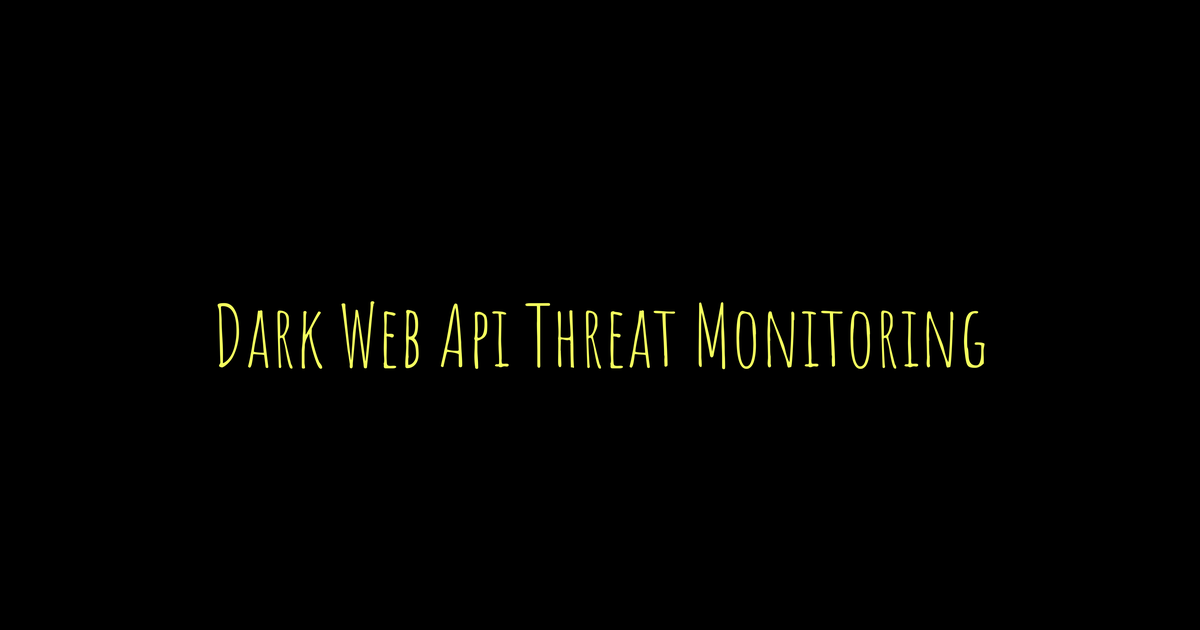Integrating Dark Web APIs for threat monitoring offers organizations a way to access real-time data from underground sources like hacker forums, breach dumps, and malware reports. This approach automates the collection of critical intelligence, such as leaked credentials and ransomware discussions, helping teams detect threats early without manual searches. By connecting these APIs with existing security tools, companies can trigger automated responses like password resets or access blocks when risks are spotted. Key integration steps include securing authentication with API keys or OAuth tokens, handling errors properly, and ensuring encrypted communication. Despite challenges like noisy data and varying update rates, this integration improves efficiency and strengthens overall cybersecurity defenses.
Table of Contents
- Overview of Dark Web APIs for Threat Monitoring
- Use Cases and Benefits of Dark Web API Integration
- Common Data Sources and Types of Monitored Information
- Core Components of Dark Web API Integration
- Best Practices for Dark Web API Integration
- Security Measures for Dark Web API Use
- Step-by-Step Guide to Implementing Dark Web APIs
- Examples of Dark Web API Providers and Features
- Challenges and Limitations of Dark Web API Integration
- Maintaining and Updating Dark Web API Integrations
- Frequently Asked Questions
11.1. What is a Dark Web API and how does it help in threat monitoring?
11.2. How can companies safely integrate a Dark Web API without exposing themselves to risks?
11.3. What kind of data can be collected from the dark web using an API for monitoring purposes?
11.4. How does automation with a Dark Web API improve the efficiency of threat monitoring?
11.5. What challenges might organizations face when using Dark Web APIs for threat monitoring?
Overview of Dark Web APIs for Threat Monitoring
Dark Web APIs provide programmatic access to data gathered from underground sources like marketplaces, hacker forums, data breach dumps, and malware-infected devices. These APIs automate the collection of threat intelligence such as leaked credentials, stolen data, ransomware activity, and other cyber threats that could impact an organization. By integrating these data feeds directly into security platforms, organizations can continuously monitor the dark web without manual searches, helping them spot risks early. The data accessed includes compromised credentials, threat actor communications, and indicators tied to cybercrime activities. Many APIs support real-time or near real-time alerts, enabling security teams to respond quickly to emerging threats. The structured data returned, typically in JSON or XML, can be parsed and analyzed by security tools or analysts, enhancing the visibility of underground activities while maintaining operational security by avoiding direct dark web browsing. Additionally, these APIs often offer filtering options to focus on specific risk levels, targeted assets, or industries, making them a critical component of modern threat intelligence ecosystems.
Use Cases and Benefits of Dark Web API Integration
Dark Web API integration offers several practical use cases that strengthen an organization’s security posture. One key benefit is early detection of compromised credentials or leaked data before attackers can exploit them. For example, if employee login details appear on a dark web marketplace, the integration can trigger automated security actions like forcing password resets or blocking access to prevent breaches. It also allows continuous monitoring of third-party vendors and partners, helping organizations spot breaches that could indirectly impact their operations. Automating this surveillance reduces manual effort and operational costs by providing 24/7 real-time threat visibility. By feeding dark web intelligence into broader threat intelligence platforms, organizations gain enriched insights that improve risk assessment and incident response. Dark web data helps detect targeted ransomware or phishing campaigns early, enabling faster and more accurate responses. It supports compliance by tracking potential data exposure incidents and provides historical data useful for forensic investigations. Additionally, continuous monitoring of attacker chatter and emerging threats enables proactive defense strategies, allowing security teams to stay ahead of evolving risks.
Common Data Sources and Types of Monitored Information
Dark web APIs gather data from a variety of underground sources critical for threat monitoring. Key among these are dark web marketplaces where stolen credentials, personal information, and financial data are openly traded. Monitoring these markets helps identify compromised accounts before attackers exploit them. Hacker forums and private chat groups provide insight into active discussions about vulnerabilities, exploits, and planned attacks, revealing emerging threat actor tactics and techniques. Data breach dumps containing exposed usernames, passwords, and sensitive records are another vital source, offering snapshots of leaked information that could impact organizations or their partners. Additionally, malware-infected devices often report stolen or compromised data back to threat actors, which is sometimes observed through underground channels. Communications from ransomware gangs expose their target lists, ransom demands, and evolving attack methods, giving early warnings about potential ransomware campaigns. APIs also track signs of identity theft attempts and fraudulent account creations that could signal ongoing attacks or social engineering efforts. Brand impersonation, domain spoofing, and phishing campaign indicators appear frequently on dark web channels, helping organizations detect and block fraudulent activities targeting their customers or employees. Leaked internal documents or confidential files shared on these platforms can reveal sensitive business information or intellectual property at risk. Finally, exploit kits and malware toolkits advertised or distributed underground provide details on the tools attackers use, while continuous monitoring of underground communities uncovers new or shifting tactics, techniques, and procedures (TTPs) used by threat actors. Integrating these diverse data types through APIs enables comprehensive visibility into the dark web’s threat landscape, improving the ability to detect and respond to cyber risks proactively.
Core Components of Dark Web API Integration
Dark Web API integration relies heavily on RESTful API endpoints that allow organizations to request specific data such as leaked credentials, breach events, and threat chatter. These endpoints typically return data in structured formats like JSON or XML, which include essential details such as timestamps, source information, and severity levels to help prioritize threats. To secure access, common authentication methods include API keys, OAuth tokens, Basic Auth, and IP allowlisting, ensuring only authorized systems can query sensitive dark web intelligence. Rate limiting is a critical feature imposed by most APIs to prevent service abuse and manage traffic loads, protecting the stability of the data provider. Many vendors also offer optional webhook support, enabling push notifications for real-time alerts when new threat data emerges, reducing the need for constant polling. Handling large volumes of data is made easier by pagination and filtering parameters, which help focus queries on relevant subsets of intelligence without overwhelming internal systems. Robust error handling is essential, with APIs providing clear response codes and messages to gracefully manage failed requests or invalid parameters during integration. To aid developers, comprehensive documentation and software development kits (SDKs) are often available, simplifying the implementation and reducing integration time. Secure transport protocols such as HTTPS are standard to protect data in transit from interception or tampering. Lastly, API versioning ensures that integrations remain compatible as providers update or enhance their services, allowing organizations to adopt new features without disruption. Together, these components establish a solid foundation for effective and secure dark web threat monitoring through API integration.
- RESTful API endpoints to request data such as leaked credentials, breach events, and threat chatter
- Authentication methods including API keys, OAuth tokens, Basic Auth, and IP allowlisting to secure access
- Data formats primarily JSON or XML containing structured threat intelligence with timestamps, sources, and severity
- Rate limiting to control API usage and prevent service abuse or overloads
- Optional webhook support for push notifications on new threat data or alerts
- Pagination and filtering parameters to manage large data sets and focus on relevant intelligence
- Error response codes and messages to handle failed requests or invalid parameters gracefully
- Documentation and SDKs provided by API vendors to facilitate integration
- Secure transport protocols such as HTTPS to protect data in transit
- Versioning to maintain compatibility and support updates without disrupting existing integrations
Best Practices for Dark Web API Integration
When integrating Dark Web APIs for threat monitoring, securing access is critical. Use strong authentication methods like OAuth or API keys combined with IP whitelisting, and rotate credentials regularly to limit exposure. Always transmit data over encrypted HTTPS connections to protect sensitive intelligence during transfer. Implement thorough error handling to gracefully manage issues like rate limits, API downtime, or malformed responses, ensuring your system remains stable. Validate and sanitize all incoming data to prevent injection attacks and avoid corrupting your threat database. Keep detailed logs of API requests and responses for auditing, troubleshooting, and compliance needs. Design your integration to scale efficiently as data volumes grow or during sudden spikes in threat activity. Automate workflows by integrating API data with SIEM, SOAR, or ticketing systems to speed up detection and response efforts. Stay alert to API version updates and adapt your integration promptly to maintain compatibility and access. Limit requests to only necessary data fields to reduce risk and improve performance. Lastly, thoroughly test the integration in a controlled environment before deploying to production to catch issues early and ensure smooth operation.
Security Measures for Dark Web API Use
Restricting API access to trusted internal systems is crucial, typically achieved through IP allowlisting or network segmentation, to reduce exposure to unauthorized users. Store API keys and secrets securely using vaults, encrypted storage, or environment variables to prevent accidental leaks or theft. Apply the principle of least privilege by requesting only the necessary data fields and permissions, limiting the scope of potential damage if credentials are compromised. Always comply with data privacy laws, especially when handling personal or sensitive information gathered from dark web sources, to avoid legal repercussions. Regularly conduct security assessments, including penetration testing of the integration components, to identify and fix vulnerabilities early. Monitor API usage actively for unusual patterns such as spikes in requests or access from unexpected IPs, which could indicate misuse or credential compromise. Where supported, enable multi-factor authentication (MFA) on API management portals to add an extra layer of security beyond passwords or keys. Keep all software dependencies used in the integration up to date and free from known vulnerabilities to reduce attack surfaces. Develop and maintain incident response plans tailored to breaches involving dark web intelligence, ensuring swift containment and recovery. Finally, review API credentials regularly and revoke those no longer in use or assigned to inactive accounts to minimize risk from orphaned access.
Step-by-Step Guide to Implementing Dark Web APIs
Start by registering with a reputable dark web monitoring service and obtain your API credentials, such as API keys or OAuth tokens. Before coding, carefully review the API documentation to understand available endpoints, authentication methods, rate limits, and the data formats you will receive (usually JSON or XML). Develop integration scripts or modules that regularly query the API or listen for webhook notifications, depending on the service capabilities. Once data is retrieved, parse and normalize it to fit your internal threat intelligence schemas, enriching the information if needed with context like asset ownership or risk scoring. Set up alerting mechanisms to notify your security team immediately when critical threats or exposures are detected, ensuring timely response. Integrate the dark web data feed with your existing security platforms, such as SIEM or SOAR tools, to automate workflows like incident creation or policy enforcement. Test the entire integration thoroughly in a staging environment to verify data accuracy, error handling, and system performance under expected loads. After validation, deploy the integration to production and implement monitoring to track uptime, API usage, and anomalies. Maintain the integration by regularly rotating credentials, updating your codebase for API version changes, tuning performance, and refining alert thresholds based on operational feedback and evolving threat landscapes. This stepwise approach helps ensure your dark web monitoring is reliable, actionable, and aligned with your organization’s security objectives.
Examples of Dark Web API Providers and Features
Several notable providers offer Dark Web APIs tailored for threat monitoring, each with distinct features and capabilities. Breachsense delivers real-time feeds covering compromised credentials, malware indicators, and attack surface data, backed by responsive customer support to help with onboarding and threat analysis. Dark Web ID, part of Kaseya, employs Basic Authentication combined with IP safelisting to secure access and focuses on monitoring leaked credentials and sensitive information. CrowdStrike Falcon Intelligence stands out by integrating dark web data with broader threat intelligence, enabling automated incident response workflows. Many of these providers support webhook notifications to push new threat data instantly, reducing the need for constant polling. APIs vary widely in update frequency, depth of data, and source coverage depending on vendor resources and technology. To help customize threat detection, several offer filtering options based on industry sectors, geographic regions, or risk levels, allowing organizations to focus on relevant exposures. Technical integration is often eased by SDKs or example code snippets in popular programming languages, which help reduce development time. While open-source tools exist for dark web monitoring, they typically lack the comprehensive coverage, timely updates, and professional support found in commercial solutions. Pricing models differ significantly, usually depending on data volume, refresh rates, and additional features such as advanced analytics or dedicated support. When selecting a provider, organizations should weigh these factors against their specific monitoring needs and existing security infrastructure.
| Provider | Authentication Method | Key Features | Additional Notes |
|---|---|---|---|
| Breachsense | Not specified | Real-time feeds of compromised credentials, malware indicators, attack surface data | Responsive customer support |
| Dark Web ID (Kaseya) | Basic Authentication with IP safelisting | Leaked credential monitoring | Focus on sensitive data exposure |
| CrowdStrike Falcon Intelligence | Not specified | Dark web data integrated with broader threat intelligence | Supports automated incident response |
| Open-source tools | Varied | Coverage and support less comprehensive | May lack full vendor support |
| Commercial APIs | Varied | Update frequency, data depth, and source coverage vary | Filtering by industry, geography, risk level available |
| Multiple providers | Varied | Integration examples and SDKs provided | Support services include onboarding and data analysis |
| Pricing models | N/A | Based on data volume, frequency, and feature sets | Varies significantly between providers |
Challenges and Limitations of Dark Web API Integration
Integrating Dark Web APIs for threat monitoring comes with several challenges. One major issue is the high volume of noise and false positives in the data, which requires careful filtering and validation to avoid wasting resources on irrelevant alerts. Legal restrictions can also limit access to certain dark web sources, making compliance checks necessary to avoid regulatory issues. The latency in data updates varies among providers, which can delay timely detection of emerging threats. Integration complexity depends heavily on the maturity and compatibility of your existing security infrastructure; less mature systems may struggle to handle or normalize dark web data effectively. Additionally, some threat actors use encryption or hidden communication channels that standard APIs and crawlers cannot access, causing gaps in intelligence coverage. The sheer volume of data can overwhelm systems if not properly prioritized, potentially leading to missed critical alerts. Costs may escalate when dealing with large data volumes or premium intelligence features, which can strain budgets. Dark web environments evolve constantly, requiring continuous updates to crawling and parsing techniques to maintain effectiveness. Limited standardization among APIs complicates integration efforts and data normalization, forcing organizations to build custom solutions. Finally, reliance on third-party providers introduces risks such as service disruptions or discontinuation, which can impact ongoing threat monitoring and response.
Maintaining and Updating Dark Web API Integrations
Effective maintenance of dark web API integrations involves continuous monitoring of API usage and performance metrics to spot bottlenecks or failures early. Staying informed about API version changes or deprecations through vendor updates is essential to prevent disruptions. Regular rotation of API credentials, combined with secure storage of secrets, helps reduce the risk of unauthorized access. As the threat landscape shifts, adjusting filtering rules and alert thresholds based on operational feedback keeps detection relevant and reduces false positives. Periodic security reviews and penetration tests of integration components should be conducted to identify vulnerabilities before they can be exploited. Reviewing logs consistently aids in spotting anomalies or unauthorized access attempts that might indicate a compromise. After any update, thorough testing of the integration confirms compatibility and ensures data integrity is preserved. Maintaining detailed documentation of the integration architecture, workflows, and troubleshooting procedures supports efficient incident response and onboarding. Coordination with vendor support teams is crucial for timely resolution of issues and to request new features that improve monitoring capabilities. Finally, planning for scalability is necessary as data volumes and organizational needs grow, ensuring that the integration remains performant and reliable under increased load.
Frequently Asked Questions
1. What is a Dark Web API and how does it help in threat monitoring?
A Dark Web API is a tool that allows you to access data from the dark web, like forums or marketplaces, where cybercriminals operate. It helps threat monitoring by providing real-time information on potential risks like leaked data, stolen credentials, or emerging scams.
2. How can companies safely integrate a Dark Web API without exposing themselves to risks?
Companies can integrate a Dark Web API safely by using secure authentication methods, limiting data access to essential personnel, and working through trusted vendors. Proper monitoring and regular audits also reduce the chance of accidental exposure or misuse of sensitive information.
3. What kind of data can be collected from the dark web using an API for monitoring purposes?
An API can collect a variety of data such as stolen credentials, data breach details, phishing campaigns, hacking tools for sale, and discussions about vulnerabilities. This information helps organizations stay ahead by spotting threats before they impact their systems.
4. How does automation with a Dark Web API improve the efficiency of threat monitoring?
Automation with a Dark Web API speeds up the collection and analysis of dark web data, reducing manual work. It delivers timely alerts and integrates with existing security tools, allowing teams to respond faster and focus on critical threats instead of sifting through large amounts of raw data.
5. What challenges might organizations face when using Dark Web APIs for threat monitoring?
Organizations might face challenges like dealing with unstructured or noisy data, understanding the context of dark web content, and ensuring data accuracy. There are also technical hurdles in integration and the need to keep up with constantly changing dark web environments.
TL;DR Dark Web APIs offer automated, real-time access to underground data like leaked credentials and threat actor chatter, helping organizations detect threats early and respond faster. Integrating these APIs improves security workflows by reducing manual monitoring, enabling automated alerts, and enriching threat intelligence platforms. Key components include secure authentication, data validation, and scalable architecture. Best practices focus on encrypted communication, error handling, and regular updates while maintaining strict security measures. Though integration can be complex and data sometimes noisy, leveraging trusted providers and following a step-by-step approach allows organizations to strengthen their cybersecurity posture effectively.





